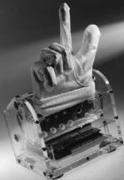1994 Project Reports
|
 |
RALPH: a fourth generation fingerspelling hand
David L Jaffe, MS
Abstract - A fourth generation computer-controlled
electromechanical fingerspelling hand called Ralph (for Robotic Alphabet) has
been developed at the Rehab R&D Center (Figure 1). The device offers
deaf-blind individuals improved access to computers and communication devices
in addition to person-to-person conversations. Enhancements in this design
include better intelligibility, smaller size, and the ability to optimize hand
positions.
 Figure 1. Ralph, the fingerspelling hand. Figure 1. Ralph, the fingerspelling hand.

Background - The majority of the estimated 20,000 adults in the US who
are deaf and blind have Usher's Syndrome, a disease characterized by deafness
at birth and a gradual loss of sight in young adulthood. Most children with
Usher's are brought up in the deaf community, learning sign language and
fingerspelling (and/or speech and lipreading) rather than braille. As their
sight diminishes they resist learning braille, which is difficult to master as
an adult and is an admission of a dual sensory loss. For this reason,
augmentative communication devices employing braille may be inappropriate for
people who are deaf and blind.
Problem - Many deaf-blind people are able to
communicate with others by using a hand-on-hand variation of the American
One-Hand Manual Alphabet. Interpreters for the deaf use this hand gesture
system (fingerspelling) to spell out words for which there are no sign language
equivalents. Instead of visually recognizing the gestures as deaf people do,
deaf-blind individuals feel and interpret the motion and positions of the hand
as the message is spelled out, one letter at a time by the interpreter.
However, fingerspelling using a human interpreter has
several disadvantages:
- Both communication partners must know fingerspelling.
- The communication partners must be in physical proximity
with each other.
- Professional interpreters are difficult to locate and
schedule.
- The presence of interpreter may intrude on the privacy
of a conversation.
- Extreme informational and social isolation can occur
without communication.
Rationale - An electromechanical hand provides a
deaf-blind person some independence in communication. Such a device typically
translates keypresses or standard computer-produced serial ASCII
representations of letters into movements of the fingers of a mechanical hand.
These movements are felt by a deaf-blind user and interpreted as the
fingerspelling equivalents of the letters comprising a message. They enable the
user to receive fingerspelled messages from the mechanical hand in response to
person-to-person communication as well as gain access to sources of
computer-based information. With a fingerspelling hand, a deaf-blind individual
need not rely on a human interpreter for all communication.
Project goal - The goal of this project is to
design, develop, and pursue commercialization of a fingerspelling hand that is
smaller, lighter, and more intelligible than our previous prototypes.
Specifically, this design implemented an improved mechanical system.
Operation - A sighted person wishing to talk to a
deaf-blind individual interacts with the fingerspelling hand through a
hand-held computer via a serial connection. (Actually, any device that produces
RS232 serial data, including terminals, modems, computers, OCR scanners, speech
recognizers, or modified closed caption systems, could be used to control the
hand.) The user interface is implemented as a menu system that provides easy
access to the unit's various functions, such as displaying and setting the
microcontroller's parameters, testing the hand motions, editing hand position
data, and entering letters to be fingerspelled.
In the fingerspelling mode, keypresses are entered on the
keyboard. The hand's software translates these keypresses into commands for the
DC servo motors. As the motor shafts rotate, they push/pull on the rods that
connect to the fingers' mechanical linkages. It is by this coordinated series
of motor commands that keyboard input is transformed into choreographed motion
representing fingerspelling.
Testing and evaluation - Evaluation of previous
fingerspelling hands has been performed by Gallaudet University (Washington,
DC) and AI duPont Institute (Wilmington, DE). Nine deaf-blind people tested the
hands over a two month period. They identified confusing letter combinations
and suggested improvements for a commercial prototype.
Technology transfer - A collaborative effort with
prospective manufacturer has begun. This activity should result in the
production of a commercial device that can be employed by deaf-blind people.
A potential solution exists for the provision of
fingerspelling hands to deaf-blind people. Within California (and some other
states), all telephone subscribers support a fund which provides telephone
access equipment for persons with disabilities. Commercial versions of this
fingerspelling hand could be furnished at no charge to deaf-blind people under
this program.
All encounters with Ralph and previous fingerspelling
hands have been enthusiastic, positive, and at times, highly emotional. The
increased communication capability and ability to "talk" directly
with people other than interpreters are powerful motivations for using
fingerspelling hands. They have the potential to provide deaf-blind users with
untiring personal communication at rates approaching that of a human
interpreter.
Republished from the 1994 Rehabilitation R&D
Center Progress Report.
|
 |
|